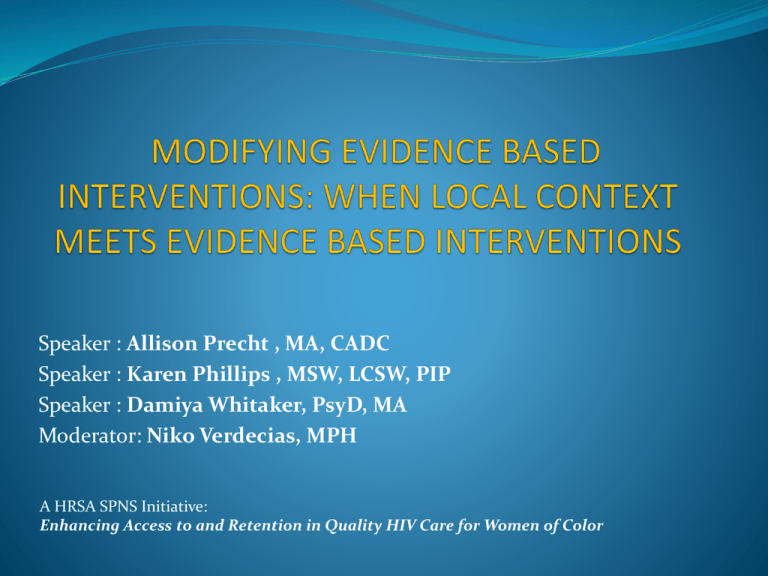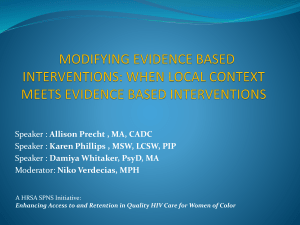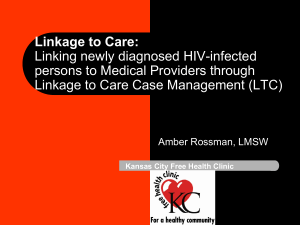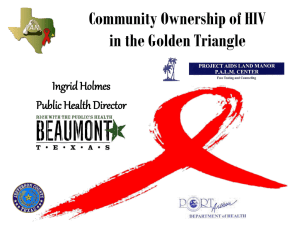
Speaker : Allison Precht , MA, CADC
Speaker : Karen Phillips , MSW, LCSW, PIP
Speaker : Damiya Whitaker, PsyD, MA
Moderator: Niko Verdecias, MPH
A HRSA SPNS Initiative:
Enhancing Access to and Retention in Quality HIV Care for Women of Color
Introduction to Initiative
and Workshop
The Ruth M Rothstein CORE Center
Chicago, IL
Project WE CARE
(Women Empowered to Connect And Remain
Engaged in Care)
Experiences with the CDC DEBI
Healthy Relationships
Allison M. Precht, MA, CADC- Project Manager
Marisol Gonzalez, RN, MPH – Principal Investigator
Susan Ryerson Espino, PhD – Lead Evaluator
The Ruth M. Rothstein Core Center
Chicago, IL
•Cook County Health and Hospitals System – Public “Safety-Net”
Facility
•5,000 active patients, 35,000 primary care visits annually
•64% African American and 20% Hispanic/Latino
•Frequent history of drug use, incarceration
•Approximately 1200 women with HIV annually.
•An estimated 70-75% of all HIV infected women and 25-30% of
HIV infected children known to be in care in the Chicago area.
Background Healthy Relationships
DEBI (CDC Diffusion of Effective Behavioral
Interventions).
5-session (two hours each session), small-group
(6-8 people) intervention for men and women
living with HIV/AIDS.
Based on Social Cognitive Theory; focuses on
developing skills and building self-efficacy to
make informed and safe decisions about disclosure
and behaviors.
Core & modifiable key components
CORE Preparation
HR has been resource intensive
Large staff training
HR Consumer Advisory Board to oversee adaptation of
HR to CORE context and clientele
Significant outreach efforts & incentives to encourage
facilitate recruitment & participation
Space
Refreshments/session preparation
Modifications
Film clips
Facilitators
Series Schedule
Incentives
Resource Packets
Experiences
27 participants 20 graduates
Significant impact on all participants (including
facilitators)
Increased peer support (incl. developing trust in female
friendships)
Disclosures
Increased self awareness and confidence in negotiating
safe sex and disclosure
Outstanding Work/Interests
Exploring ways to evaluate (process and outcome)
Considering ways to leverage resources:
Internal & external collaboration to meet needs of a
variety of stakeholders and keep costs down for any one
program
Consider ways to reduce “commitment threat” and
increase HR exposure to more women
“Deadly Secret”
by Anonymous
I have a deadly secret its name is HIV
But I’m finally going to share it because it is time that I break free
People will make fun of you the devil whispered in my ear and
From that first day I lived a life of fear. Fear of someone finding out
fear of being pushed away so I chose to keep it a secret I
Couldn’t see it any other way. One day as I was running a still
Small voice spoke to me. I couldn’t begin to understand it was GOD
Speaking to little old me didn’t he know how awful I’ve been,
does he not know that I have HIV. As if I said those thoughts out loud the
LORD began to say of course I do my child. But I love you anyway. Its more
to this then meets the eye its not only you with HIV but millions that continue
to die. They die alone in silence playing their deadly game. Holding in there
secret living with guilt and shame. I could not understand this LORD didn’t you say
you care?
OF COURSE I DO MY CHID THAT’S WHY I GIVE YOU NO MORE THAN YOU CAN
BEAR!!!!!!!!!!
ACKNOWLEDGEMENTS
We would like to thank all of the project team for their hard work:
L’Oreal Bailey
Seliciano Douthard
Yolanda Duplessis
Debbie Mata
Nichelle Pierson
Wendy Rebolledo
Katherine Roach
Karen Phillips, LCSW, PIP
Project Coordinator
Health Services Center, Inc.
Hobson City, AL
Project Team, Collaborators and
Contributors
HSC Team
Barbara Hanna, MD
PI, HSC Medical Director
Tawanah Fagan, LBSW
Tiffany Garrett, BSW
Heather Watts, MSW
Mellissa Stearns, BSW
Cathy Simpson, Ph.D..
Evaluator
CDC Original ARTAS
Collaborators
Lytt Gardner, Ph.D.
Jason Craw, MS
Christine O’Daniel, RN
Richard Rapp, Ph.D.,
expert consultant
HSC Overview
1987: Began as support agency for
persons with HIV/AIDS in the
Calhoun County, AL area
HSC Service Area: 14 Northeast
Alabama counties=9,001 square
miles (AL Public Health Areas V and
VI)
Only provider of HIV care in the
service area
HSC service area covers 18% of
Alabama.
Target population for SPNS WOC
project: all women of color, enrollees
predominantly African-American
Strengths-Based Case
Management: Overview
Originally developed with substance using and MI populations
Utilizes client-identified strengths as basis for behavior change
Case managers assist clients in identification of strengths and
prior life successes that may be utilized to meet current life
challenges
Uses Motivational Interviewing techniques to help clients
identify issues and works with clients to set measurable goals
and action steps
Core Assumptions: client-driven, individualized, focus on
strengths not deficits/weaknesses
SBCM and ARTAS Linkage to Care
Applied SBCM to HIV/linkage to care issues with the manualized ARTAS model
Original ARTAS model provided brief (> 5 sessions) to link newly diagnosed (only)
persons into care
Following sessions, participants linked to ongoing CM
ARTAS Linkage focused on using SBCM to help clients build relationships with
medical/ancillary providers, navigate healthcare, encourage appt. keeping,
build rapport, honor client decisions
Two multi-site studies indicate that ARTAS SBCM increased initial linkage and
long-term retention over standard HIV care (e.g., Craw et al., 2010; Gardner et al.,
2005)
HSC Adapted initial ARTAS SBCM to extend access to linkage sessions and to
engage women experienced with care but in crisis that threatens retention
Why modify? Nature of women’s issues, clinical experience, drop-out as significant
a problem as initial linkage
Application to Linkage to Care for
Women of Color
Adapted initial ARTAS SBCM to extend access to linkage sessions and to
engage women experienced with care but not optimally engaged or retained
Why modify? Specific rural needs and clinical site experience. Nature of
women’s issues, clinical experience, drop-out as significant a problem as initial
linkage, drop outs relatively common
Broadly, how was ARTAS adapted?
Linkage CMs stationed at public health departments facilitates quick access to
newly diagnosed women and builds staff/DIS relationships
In adaptation, linkage sessions access is ongoing
Focuses on initial linkage
Continues focus on longer-term retention
Troubleshoots resolution of problems that may lead to drop-out/loss to care
Linkage CMs perform linkage functions and meet at least quarterly with clients
(more sessions for clients in crisis, based on acuity levels)
HSC Adaptation of Original ARTAS Model
Original ARTAS
Various sites had multiple
recruitment streams
Enrolled all genders and
races/ethnicities
Model applied only to persons newly
diagnosed with HIV
Clients limited to 5 total visits, visits
limited to within 1st 3 months
following diagnosis
3 visits necessary for adequate
“dosage”
HSC Adaptation*
HD caseworker placement and
targeted recruitment streams
Enroll women of color only
Newly diagnosed, sporadic in care,
*Adaptation conducted in
Collaboration with one of original
ARTAS developers, expert consultant,
Richard Rapp, MSW, Ph.D.
and lost to care eligible
Minimum dose: 5 sessions in 4
month period following initial
enrollment
No maximum dosage/visit limit
Ongoing minimum dosage: from
month 5 onward minimum 1
contact per month
Use of acuity to assist in
determining contacts
Preliminary HSC Multi-site Linkage/Retention Data
Acuity of Need Total Score
15
Average Client Contacts First Four Months
following enrollment
7.00
6.00
5.00
4.00
3.00
2.00
1.00
0.00
10
6.10
5
0
3.40
Intake
Most Recent
Dosage and Retention in Care
CM Contacts
Medical Provider
Contacts
100
80
60
40
20
0
% Currently retained in
medical
% Lost to Care/Sporadic
Lessons Learned/Experience with
Modifications
Clients will utilize much higher levels of CM access than
the original 5 ARTAS sessions, if it is provided
Important to work directly with original model developers
(e.g., fidelity, appropriate changes to model)
CM/client relationship is critical
Initial rapport building is key
Access to CM services needs to be ongoing
Ongoing relationship management with referral sources is
important
LIFT Project – Cumberland County, NJ
Luz Amparo Pinzon, Ph.D. and Damiya Whitaker, PsyD, MA
LIFT Project Overview
Needs Assessment
Baseline Measures
INTERVENTION
Support Services,
Case Management,
Referral Network
Curriculum
Workshops,
Outreach
Core Elements of SISTA and Yo Me Cuido
Focused on empowerment, modeling, skill building, and gender
specific issues.
Designed for implementation in a community-based setting.
Aimed at reducing HIV sexual risk behaviors by increasing safer
behaviors, developing positive attitudes toward safer sex, enhancing
communication skills and increasing control over sexual situations.
Sessions build on each other and encourage open group participation.
Incorporate games and other interactive teaching/learning tools.
Overview of Yo Me Cuido
Group level intervention, two 5-hour sessions.
Interactive; culturally appropriate.
Designed to:
Improve HIV/AIDS related knowledge
Promote safe sex behaviors
Increase self-efficacy
Evaluation: Pre- and post-test; 3-month follow-up.
Modifications
SISTA
Latina Adaptation
African American
Adaptation
Based on social cognitive & gender
and power theories
Based on health belief, social
cognitive & gender and power
theories
Based on health belief, social
cognitive & gender and power
theories
Designed for young African American
women
Designed for women with low literacy
skills and limited English Proficiency
Designed for women with low literacy
skills
Delivered in five 2-hour sessions
Delivered in two 5-hour sessions
Delivered in two 5-hour sessions
Focus: Prevention
Focus: Treatment & Adherence
(Expanded to include opportunistic
diseases, nutrition and exercise)
Focus: Treatment & Adherence
(Expanded to include opportunistic
diseases, nutrition and exercise)
Focus: Assertiveness Skills
Focus: Negotiation Skills
Focus: Negotiation Skills
Focus: Sexual Risk Behaviors
Focus: Sexual Risk Behaviors with
Emphasis on Re-infection
Focus: Sexual Risk Behaviors with
Emphasis on Re-infection
Emphasis on partner involvement
Emphasis on self-efficacy
Emphasis on self-efficacy
Use of poems
Use of role model stories
Use of role model stories
Booster sessions at 2 & 4 months
post-intervention
Booster session is at 6 months postintervention
Booster sessions at 6 months postintervention
Cultural Adaptations
Based on formative findings the curriculum incorporates key issues of
Latino culture that put them at risk:
Feminization of HIV (gender discrimination and violence)
Traditional gender roles (machismo/marianismo )
Familialism (self-sacrifice for the benefit of the family)
Passivity (avoiding insisting on safe sex, when this can lead to
confrontation)
Fatalism (individual has no control over situations)
Dignity (maintaining honor in the family and group)
Cultural Adaptations
Adaptations for African Americans were based on cultural and behavioral
practices that put them at risk:
Traditional gender roles
Pride in devotion and service to others
Religious beliefs
Tendency to self-neglect
Low levels of interpersonal power
Concurrent sexual partners
Lessons Learned
1. Despite diagnosis, women still lack basic knowledge about HIV/AIDS
2. Role model stories seem to resonate with participants and facilitate
discussions on topics that were previously uncomfortable for
participants.
3. Women with low literacy skills and limited English Proficiency skills
benefit from the use of games and other interactive teaching methods.
4. Women now understand the relationship between nutrition and
staying healthy.
5. Women often do not understand the link between unsafe sexual
behaviors and re-infection.
Question &
Answer
Thank you!








